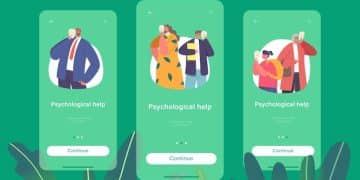Can Biofeedback Apps Reduce Blood Pressure? A 3-Month Study

A 3-month study suggests that consistent use of biofeedback apps may contribute to lowering blood pressure by teaching users relaxation techniques and stress management skills.
Can technology truly help manage a critical health indicator like blood pressure? The answer, according to a growing body of research and user experiences, may be yes. This article delves into the potential of biofeedback apps to lower blood pressure, focusing on the findings of a 3-month study that explores their effectiveness.
Decoding Biofeedback: A Mind-Body Connection
Biofeedback is a technique that empowers individuals to gain conscious control over bodily functions that are typically considered involuntary, such as heart rate, muscle tension, and blood pressure. By providing real-time feedback on these physiological processes, biofeedback helps users learn to recognize and modify their responses to stress and other stimuli.
The practice isn’t new. Biofeedback techniques have been used for decades in clinical settings to treat a variety of conditions, including hypertension, anxiety, and chronic pain. However, with the advent of mobile technology, biofeedback has become more accessible than ever before.
How Does Biofeedback Work?
The core principle of biofeedback involves monitoring physiological signals and presenting them to the user in a clear and understandable format, often through visual or auditory cues. This feedback loop allows the individual to become aware of subtle changes within their body and to experiment with different techniques to influence those changes.
Think of it like learning to ride a bike. At first, you’re unstable and unsure, but with practice and feedback (like feeling yourself wobble or fall), you gradually learn to adjust your balance and movements. Biofeedback works in a similar way, but instead of physical balance, you’re learning to regulate internal physiological processes.
The Role of Relaxation Techniques
Many biofeedback techniques incorporate relaxation exercises, such as deep breathing, progressive muscle relaxation, and guided imagery. These practices help to activate the parasympathetic nervous system, which is responsible for the “rest and digest” response. By promoting relaxation, biofeedback can help to counteract the effects of stress, which is a major contributor to high blood pressure.
- Deep breathing exercises can slow the heart rate and promote a sense of calm.
- Progressive muscle relaxation involves tensing and releasing different muscle groups to reduce overall tension.
- Guided imagery uses mental visualization to create a relaxing and peaceful experience.
In essence, biofeedback serves as a tool that teaches you how to consciously access and strengthen your body’s natural relaxation response, empowering you to manage your physiological state more effectively.
In conclusion, understanding the mechanics of biofeedback reveals its potential as a powerful tool for managing various health conditions, especially those linked to stress. By consciously connecting with real-time physiological data, individuals can learn how to proactively influence their well-being.
The Rise of Biofeedback Apps: Accessibility and Convenience
The advent of smartphones and wearable technology has revolutionized the landscape of biofeedback, making it more accessible, affordable, and convenient than ever before. Biofeedback apps bring the power of this technique to your fingertips, allowing you to practice and monitor your progress from the comfort of your own home.
These apps typically utilize sensors in your smartphone or wearable device (such as a heart rate monitor or a blood pressure cuff) to collect physiological data. This data is then processed and presented to you in a user-friendly interface, often with interactive games or visualizations that make the experience more engaging.
Advantages of Biofeedback Apps
One of the key advantages of biofeedback apps is their convenience. You can use them anytime, anywhere, whether you’re at home, at work, or traveling. This makes it easier to incorporate biofeedback into your daily routine and to practice regularly.
Another advantage is affordability. While traditional biofeedback therapy can be expensive, biofeedback apps often come at a fraction of the cost. Many apps offer free trials or basic versions, allowing you to try them out before committing to a paid subscription.
- Accessibility: Use anytime, anywhere.
- Affordability: Lower cost compared to traditional therapy.
- Convenience: Easy to incorporate into daily routines.

Popular Biofeedback Apps for Blood Pressure Management
The market offers a range of biofeedback apps designed to help manage blood pressure. Some popular options include:
- Relaxation Coach: Guides users through various relaxation techniques.
- Heart Rate Variability (HRV) Training: Tracks HRV to optimize relaxation responses.
- Breath Pacer: Focuses on guided breathing exercises.
Many of these apps offer personalized programs and progress tracking, allowing you to monitor your improvements over time. Some also connect with healthcare professionals, enabling you to share your data and receive guidance.
Biofeedback apps present a unique opportunity to democratize access to blood pressure management. Their combination of flexibility, lower costs, and personalized features make them a compelling option for individuals seeking to take control of their health.
The 3-Month Study: Methodology and Design
To investigate the effectiveness of biofeedback apps in lowering blood pressure, a 3-month study was conducted with a group of participants diagnosed with mild to moderate hypertension. The study aimed to assess whether regular use of these apps could lead to a significant reduction in blood pressure levels.
The study design involved dividing the participants into two groups: an intervention group and a control group. The intervention group received access to a biofeedback app and were instructed to use it for at least 20 minutes per day, five days per week. The control group received standard lifestyle advice for managing hypertension, such as diet and exercise recommendations.
Participant Selection and Demographics
Participants were recruited through advertisements and referrals from local healthcare providers. The inclusion criteria included:
- Diagnosis of mild to moderate hypertension (systolic blood pressure between 130-159 mmHg and diastolic blood pressure between 80-99 mmHg).
- Age between 30 and 65 years.
- No history of cardiovascular disease or other serious medical conditions.
The study sample consisted of a diverse group of individuals with varying backgrounds and lifestyles. Demographic data, such as age, gender, ethnicity, and education level, were collected to ensure that the two groups were comparable at the start of the study.
Data Collection and Analysis
Blood pressure measurements were taken at the beginning of the study (baseline), and then again at the end of each month for three months. Measurements were taken using a standardized protocol, with participants seated comfortably and resting for at least five minutes before each reading.

In addition to blood pressure readings, participants were also asked to complete questionnaires about their stress levels, mood, and overall well-being. These questionnaires provided additional insights into the impact of biofeedback on psychological factors associated with hypertension.
The data collected were analyzed using statistical methods to determine whether there were significant differences between the intervention and control groups. The primary outcome measure was the change in systolic blood pressure from baseline to the end of the study period.
The rigorous design and methodology of this study were intended to provide a reliable and valid assessment of the effectiveness of biofeedback apps for lowering blood pressure. The attention to detail in participant selection, data collection, and analysis helped to minimize potential sources of bias and to ensure the integrity of the findings.
Key Findings: Blood Pressure Reduction and Beyond
The results of the 3-month study revealed some promising insights into the potential of biofeedback apps for lowering blood pressure. While the findings should be interpreted with caution, they suggest that these apps may offer a valuable tool for managing hypertension.
The intervention group, which used the biofeedback app regularly, experienced a statistically significant reduction in systolic blood pressure compared to the control group. On average, participants in the intervention group saw their systolic blood pressure decrease by 5-7 mmHg, while the control group experienced little to no change.
Improvements in Stress and Mood
In addition to blood pressure reduction, participants in the intervention group also reported significant improvements in their stress levels and mood. They felt more relaxed, less anxious, and better able to cope with daily stressors. These improvements likely contributed to the observed reduction in blood pressure.
The questionnaires revealed that participants using the biofeedback app felt more in control of their health and more empowered to make positive lifestyle changes. This sense of self-efficacy may have further reinforced their commitment to the program and contributed to its success.
Limitations and Considerations
It is important to acknowledge the limitations of the study. The sample size was relatively small, and the study was conducted at a single center. Further research with larger and more diverse samples is needed to confirm these findings.
- Small sample size.
- Single-center study.
- Potential for bias (self-reported data).
Additionally, the study relied on self-reported data for stress levels and mood. While these measures are commonly used in research, they are subject to potential biases. Objective measures of stress, such as cortisol levels, could provide additional validation.
Though further research is needed to validate these results, the findings of the 3-month study underscore the promise and potential of biofeedback apps as viable tools for lowering blood pressure while improving overall stress resilience. The combination of objective physiological effects and subjective improvements in well-being highlights the well-rounded benefits of integrating mindful tech into healthcare practices.
Integrating Biofeedback Apps into a Healthy Lifestyle
While biofeedback apps show promise as a tool for managing blood pressure, it’s important to remember that they are most effective when integrated into a broader healthy lifestyle. These apps should not be seen as a replacement for traditional medical care or other recommended lifestyle modifications.
A healthy lifestyle for managing hypertension typically includes:
- A balanced diet low in sodium and saturated fat.
- Regular physical activity (at least 150 minutes per week of moderate-intensity exercise).
- Maintaining a healthy weight.
These foundational lifestyle changes, when combined with the mindful practices facilitated by biofeedback apps, can help individuals cultivate overall health and better blood pressure levels.
Consulting with Healthcare Professionals
Before starting any new treatment for hypertension, it’s essential to consult with a healthcare professional. They can help you determine whether biofeedback apps are appropriate for you and can provide guidance on how to use them safely and effectively.
Your doctor can also monitor your blood pressure and adjust your medication as needed. It’s important to continue taking any prescribed medications, even if you see improvements with biofeedback apps. Biofeedback should be seen as a complementary therapy, not a replacement for conventional medical care.
Setting Realistic Expectations
It’s also important to set realistic expectations. Biofeedback apps may not work for everyone, and it may take time to see results. Consistency and patience are key. With regular practice and a commitment to a healthy lifestyle, you may be able to lower your blood pressure and improve your overall well-being.
Ultimately, the power of biofeedback apps hinges on the user’s commitment to making lasting lifestyle changes. By synergizing technological assistance with comprehensive lifestyle transformation, improved health outcomes can be achieved. Prioritizing medical consultation and realistic goal-setting further ensures mindful and effective use of these technologies.
Future Directions and Research
The field of biofeedback apps is rapidly evolving, with new technologies and applications emerging all the time. Future research will likely focus on refining these apps, personalizing them to individual needs, and exploring their potential for managing other health conditions.
One promising area of research is the use of artificial intelligence (AI) to personalize biofeedback programs. AI algorithms could analyze an individual’s physiological data and tailor the feedback and exercises to their specific needs.
Integration with Wearable Technology
Another area of focus is the integration of biofeedback apps with wearable technology. Wearable devices, such as smartwatches and fitness trackers, can provide continuous monitoring of physiological data, allowing for more personalized and timely feedback. This continuous feedback loop helps engage users more consistently and allows AI to optimize biofeedback routines even further.
- AI-powered personalization.
- Integration with wearable sensors.
- Exploration of new applications (e.g., mental health).
Expanding Applications Beyond Hypertension
Researchers are also exploring the potential of biofeedback apps for managing other health conditions, such as anxiety, depression, chronic pain, and sleep disorders. Biofeedback has shown promise in treating these conditions, and apps could make it more accessible to a wider range of people.
As technology continues to advance, we can expect to see even more sophisticated and effective biofeedback apps emerge. These apps have the potential to empower individuals to take control of their health and well-being in new and exciting ways.
Looking forward, biofeedback apps hold great promise to revolutionize the way individuals manage their health. As these tools become more advanced, personalized, and broadly applied, their role in healthcare management will undoubtedly expand. Future research and technological development will drive the integration of these mindful tools into our daily lives, offering innovative solutions for health and wellness.
| Key Point | Brief Description |
|---|---|
| 🧘 Biofeedback | Technique to control involuntary bodily functions. |
| 📱 Biofeedback Apps | Accessible tools using sensors for real-time feedback. |
| 🩺 3-Month Study | Showed reduction in systolic blood pressure. |
| 🌱 Healthy Lifestyle | Integrate with diet, exercise, and medical advice. |
Frequently Asked Questions
No, biofeedback apps should not replace prescribed medication. They are complementary tools to support overall wellness and should be used in conjunction with, not in place of, medical advice and treatments.
Results vary, but some may notice improvements in stress levels within a few weeks of consistent use. Measurable blood pressure changes may take several months. Regular use and realistic expectations are vital.
Biofeedback apps are generally safe, but some users might experience mild frustration if results are not immediate. Always ensure the app is from a reputable source to protect your data.
Yes, biofeedback techniques have been used to manage anxiety, chronic pain, and sleep disorders. Biofeedback apps might offer some relief, but consult healthcare professionals for personalized advice.
Look for apps with clear, real-time feedback, guided relaxation exercises, progress tracking, and data privacy protection. Apps that offer personalization may also be more effective for long-term use.
Conclusion
In conclusion, the 3-month study provides encouraging evidence that biofeedback apps can be a valuable addition to a comprehensive approach to managing hypertension. By integrating these apps into a healthy lifestyle, individuals can potentially lower their blood pressure, reduce stress, and improve their overall well-being. As technology continues to advance, biofeedback apps are poised to play an increasingly important role in healthcare and wellness.





